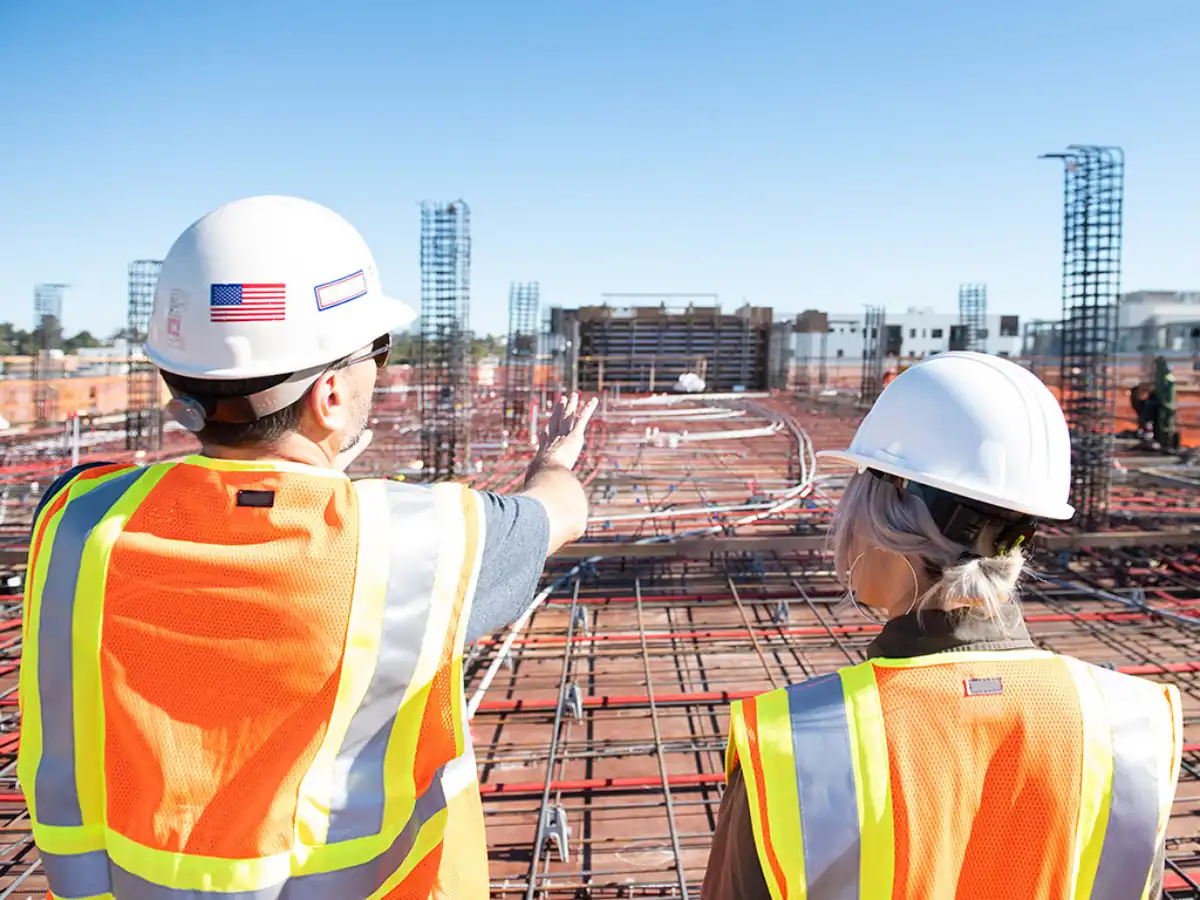Home>diy>Building & Construction>What Is Feasibility Study In Construction Project


Building & Construction
What Is Feasibility Study In Construction Project
Modified: March 6, 2024
Learn the importance of a feasibility study in a building construction project and how it helps in assessing the viability and potential success of the project.
(Many of the links in this article redirect to a specific reviewed product. Your purchase of these products through affiliate links helps to generate commission for Storables.com, at no extra cost. Learn more)
Introduction
When it comes to construction projects, thorough planning and careful consideration are crucial for success. One of the essential steps in this process is conducting a feasibility study. A feasibility study is a comprehensive analysis that helps evaluate the viability of a construction project before any resources are invested.
Feasibility studies play a vital role in determining whether a construction project is viable, both financially and technically. They provide valuable insights and help stakeholders make informed decisions based on accurate data and analysis.
In this article, we will delve into the concept of a feasibility study in construction projects and explore its importance in ensuring successful outcomes.
Key Takeaways:
- Feasibility studies help construction projects by checking if they make sense financially and technically. They also look at risks and opportunities to make smart decisions before starting.
- Feasibility studies consider market demand, costs, and environmental impact. They help stakeholders decide if a construction project is a good idea and how to make it successful.
Read more: What Do You Study In Civil Engineering
Definition of Feasibility Study
A feasibility study is an in-depth evaluation and analysis conducted to determine the practicality and viability of a construction project. It involves assessing various factors, such as technical, financial, market, legal, and environmental aspects, to gauge whether the project can be successfully executed.
The primary objective of a feasibility study is to identify potential risks, challenges, and opportunities associated with a construction project. It serves as a preliminary investigation to determine if the project aligns with the goals and objectives of the stakeholders involved.
During a feasibility study, project managers, architects, engineers, and other professionals study the project’s feasibility and provide a detailed report that outlines the findings and recommendations. This report serves as a guide for making informed decisions about whether to proceed with the project or explore alternative options.
A thorough feasibility study takes into account all aspects of the project, from the initial concept and design to the construction process, operational costs, and potential revenue generation. It considers the various constraints and limitations, such as budget constraints, regulatory requirements, and timeframes, that may impact the project’s successful completion.
In summary, a feasibility study is a comprehensive evaluation conducted to determine if a construction project is technically and financially viable, and if it aligns with strategic objectives and regulatory requirements.
Importance of Feasibility Study in Construction Projects
Feasibility studies are an essential aspect of construction projects, as they provide valuable insights and play a crucial role in ensuring successful outcomes. Here are some key reasons why feasibility studies are important:
- Risk Assessment: Feasibility studies allow project stakeholders to identify and assess potential risks associated with the construction project. By conducting a thorough analysis, they can anticipate and address challenges early on, minimizing the likelihood of delays, cost overruns, and other complications.
- Cost Evaluation: A feasibility study helps determine the estimated costs associated with the project. It includes evaluations of construction materials, labor, equipment, permits, and other expenses. This cost evaluation allows stakeholders to make informed decisions about budgeting and financial planning.
- Market Analysis: Understanding the market demand and competition is crucial for the success of a construction project. A feasibility study includes market analysis, which helps identify the target audience, assess market conditions, and determine potential demand for the project. This analysis is essential for deciding whether there is a viable market for the proposed construction.
- Technical Feasibility: Feasibility studies assess the technical aspects of the project, including the engineering requirements, materials availability, and construction methods. This evaluation helps determine if the project can be successfully executed from a technical standpoint, ensuring that the necessary resources and expertise are available.
- Environmental Impact: With increasing emphasis on sustainability and environmental responsibility, assessing the environmental impact of construction projects is crucial. Feasibility studies evaluate the potential ecological implications and help determine if the project conforms to environmental regulations and standards.
- Decision-Making Tool: The findings and recommendations of a feasibility study provide stakeholders with valuable information for making informed decisions. They can decide whether to proceed with the project, modify the plans, seek additional funding, or explore alternative options based on the feasibility study’s results.
- Project Viability: Ultimately, a feasibility study helps determine the overall viability of the construction project. It assesses the project’s potential for success and helps stakeholders determine if it aligns with their goals, strategic objectives, and financial capabilities. Conducting a feasibility study enables stakeholders to weigh the pros and cons and make informed choices before committing significant resources.
In summary, feasibility studies are a critical step in the construction project planning process. They provide valuable insights, assess risks, evaluate costs, analyze the market, and help stakeholders make informed decisions to ensure the successful execution of the project.
Key Components of a Feasibility Study
A feasibility study comprises several key components that are essential for a thorough analysis of a construction project. These components provide a comprehensive understanding of the project’s viability from different perspectives. Let’s explore the key components of a feasibility study:
- Market Analysis: This component assesses the current market conditions, demand for the project, and potential competition. It involves studying market trends, conducting surveys, and analyzing demographic data to determine if there is a market need for the proposed construction project.
- Technical Analysis: The technical analysis focuses on evaluating the technical feasibility of the project. It examines the engineering requirements, construction methods, availability of materials, and other technical factors necessary for successful project execution. This analysis ensures that the project can be completed within the required specifications.
- Financial Analysis: The financial analysis assesses the economic viability of the project. It involves estimating project costs, including construction expenses, operational costs, and potential revenue generation. Financial analysis also takes into consideration factors such as return on investment (ROI), cash flow projections, and the project’s potential profitability.
- Legal Analysis: Compliance with legal and regulatory requirements is critical in the construction industry. The legal analysis component examines zoning regulations, building codes, permits, and any legal restrictions that may impact the project. It ensures that the project can be executed in adherence to all necessary legal obligations and minimizes potential legal issues in the future.
- Environmental Analysis: Construction projects can have significant environmental impacts. The environmental analysis component evaluates the potential environmental consequences of the project. It examines factors such as air and water quality, waste management, habitat preservation, and energy efficiency. This analysis helps identify any potential environmental risks and ensures compliance with environmental laws and regulations.
- Risk Assessment: Identifying and assessing risks is a crucial component of the feasibility study. This component involves identifying potential obstacles, uncertainties, and challenges that may arise during the project’s execution. It helps stakeholders develop risk mitigation strategies and contingency plans to minimize disruptions and avoid cost overruns.
Each of these key components plays a significant role in evaluating the feasibility of a construction project. Together, they provide stakeholders with a comprehensive understanding of the project’s potential, allowing them to make informed decisions and take the necessary steps for a successful outcome.
Market Analysis
Market analysis is a crucial component of a feasibility study in construction projects. It involves evaluating the current market conditions, identifying potential customers, and assessing the demand for the proposed project. A thorough market analysis helps stakeholders determine if there is a viable market for the construction project and if it will generate sufficient demand to make it economically viable.
Here are the key aspects covered in a market analysis:
- Market Size and Growth Potential: The market size refers to the total number of potential customers or the total value of the market in which the project will operate. It is important to assess the size of the market and its growth potential to determine if there is sufficient demand to support the project and ensure its long-term success.
- Target Audience Identification: Identifying the target audience is essential in understanding the specific needs and preferences of potential customers. This involves analyzing demographic data, such as age, income level, location, and lifestyle, to determine the target market segment for the project. Understanding the target audience helps in tailoring the project to meet their requirements effectively.
- Competitor Analysis: Assessing the competition is crucial to determine the project’s positioning in the market. This involves researching and analyzing direct and indirect competitors to understand their offerings, market share, pricing strategies, and strengths and weaknesses. Understanding the competitive landscape helps stakeholders identify opportunities for differentiation and develop strategies to gain a competitive advantage.
- Market Trends and Opportunities: Monitoring market trends and identifying opportunities is essential for the success of a construction project. This involves assessing factors such as emerging technologies, changing customer preferences, and industry developments. By understanding the current trends and opportunities, stakeholders can adapt their project to meet the evolving needs of the market.
- Marketing and Sales Strategies: Developing effective marketing and sales strategies is crucial for attracting customers and generating revenue. A market analysis helps identify the most effective channels and approaches to promote and sell the project. It also assists in determining pricing strategies, understanding customer decision-making processes, and establishing realistic sales projections.
- Regulatory and Legal Considerations: Understanding the regulatory and legal aspects of the market is necessary to ensure compliance and avoid any legal issues. This includes identifying and analyzing relevant laws, regulations, permits, and certifications required for the construction project. Complying with these regulations is crucial for the project’s success and long-term sustainability.
A thorough market analysis provides stakeholders with valuable insights into the potential demand, target audience, competition, and market trends in which the construction project will operate. It helps stakeholders make informed decisions, tailor the project to meet market needs, and develop effective marketing and sales strategies to ensure its success.
Technical Analysis
Technical analysis is a critical component of a feasibility study in construction projects. It involves evaluating the technical feasibility of the project, assessing the engineering requirements, construction methods, availability of materials, and other technical factors necessary for successful project execution.
Here are the key aspects covered in a technical analysis:
- Engineering Requirements: Understanding the engineering requirements is crucial to determine if the project can be executed successfully. This involves assessing factors such as structural design, building codes and regulations, site conditions, and any specific engineering challenges that may need to be addressed.
- Construction Methods: Evaluating different construction methods is essential to determine the most appropriate approach for the project. This includes considering factors such as the type of construction, technology to be utilized, equipment requirements, and construction timeline. Selecting the right construction methods helps optimize resources, minimize costs, and ensure efficient project execution.
- Availability of Materials: Assessing the availability of construction materials is crucial to determine if the required materials can be sourced efficiently. This involves evaluating factors such as material suppliers, transportation logistics, and potential supply chain disruptions. Ensuring the availability of materials is essential to avoid delays and cost overruns during the construction phase.
- Technological Feasibility: Considering technological aspects is important in modern construction projects. This includes exploring innovative technologies, building systems, and construction methodologies that can improve project efficiency, sustainability, and safety. Assessing the technological feasibility helps determine if the project can benefit from adopting cutting-edge solutions.
- Utilities and Infrastructure: Evaluating utilities and infrastructure requirements is vital to determine if the necessary services, such as water, power, and sewage, are available at the project site. This includes assessing the capacity of existing infrastructure or determining if additional infrastructure investments are required to support the project’s functionality.
- Construction Schedule: Developing a realistic construction schedule is crucial for project planning and resource allocation. This involves estimating the duration of each construction phase, considering potential delays, and establishing milestones and deadlines. A well-planned construction schedule ensures timely project completion and minimizes disruptions.
A thorough technical analysis provides stakeholders with a comprehensive understanding of the project’s technical feasibility. It helps assess the engineering requirements, evaluate construction methods, ensure the availability of materials, and determine the technological and infrastructure considerations necessary for successful project execution.
By conducting a comprehensive technical analysis, stakeholders can make informed decisions, allocate resources effectively, and establish strategies to optimize project performance and ensure its successful completion.
A feasibility study in construction project helps determine if the project is practical, cost-effective, and achievable. It assesses potential challenges and risks before investing time and money.
Financial Analysis
Financial analysis is a crucial component of a feasibility study in construction projects. It involves evaluating the economic viability of the project and assessing its financial feasibility. A thorough financial analysis helps stakeholders understand the overall financial implications of the project and determine if it is financially viable.
Here are the key aspects covered in a financial analysis:
- Cost Estimation: Estimating the overall project cost is one of the primary objectives of the financial analysis. This includes assessing construction costs, material costs, labor costs, equipment costs, and any other related expenses. Accurate cost estimation helps stakeholders determine the financial feasibility of the project and determine if the project can be completed within the allocated budget.
- Operating Costs: In addition to the construction costs, it is essential to consider the ongoing operating costs associated with the project. This includes expenses such as maintenance, utilities, insurance, property taxes, and any other recurring expenses. Incorporating operating costs helps stakeholders assess the long-term financial sustainability of the project and plan for future expenditures.
- Revenue Generation: Evaluating the potential revenue generation is a critical aspect of the financial analysis. This involves estimating the expected income from the project, such as rental income, sales revenue, or any other revenue streams. It is important to consider market demand, pricing strategies, and projected occupancy rates when estimating revenue to ensure the project’s financial feasibility.
- Return on Investment (ROI): Assessing the expected return on investment is crucial for stakeholders. The financial analysis includes calculating the ROI by comparing the project’s expected profits against the initial investment. This metric helps stakeholders evaluate the potential profitability of the project and determine if it aligns with their financial goals and expectations.
- Cash Flow Projections: Cash flow projections help stakeholders understand the timing and amount of cash inflows and outflows throughout the project’s lifecycle. This includes considering factors such as construction progress, revenue generation, and expenses. Cash flow projections assist in managing financial resources effectively and ensure that sufficient funds are available at each stage of the project.
- Financing Options: Assessing the available financing options is crucial to determine how the project will be funded. This includes evaluating sources of financing, such as loans, equity investments, or public-private partnerships. Analyzing financing options helps stakeholders understand the financial implications, interest rates, repayment terms, and any associated risks.
A thorough financial analysis provides stakeholders with a comprehensive understanding of the project’s financial feasibility. It helps assess the project’s overall costs, revenue potential, return on investment, cash flow projections, and financing options. By conducting a comprehensive financial analysis, stakeholders can make informed decisions, assess the project’s financial viability, and plan for its successful implementation.
Legal Analysis
Legal analysis is a vital component of a feasibility study in construction projects. It involves assessing the legal and regulatory requirements that need to be considered for the successful execution of the project. Compliance with applicable laws and regulations is crucial to ensure the project’s legality, mitigate potential legal risks, and avoid costly legal disputes.
Here are the key aspects covered in a legal analysis:
- Zoning and Land Use: Understanding the zoning regulations and land use requirements is essential in determining if the proposed construction project aligns with the designated land category. It involves evaluating regulations related to building height, setbacks, land area, and other zoning restrictions. Evaluating these factors helps ensure that the intended use of the project complies with local regulations.
- Building Codes and Permits: Compliance with building codes is vital to ensure the safety, structural integrity, and functionality of the construction project. The legal analysis assesses the specific building codes and permit requirements that apply to the project. This includes obtaining permits for construction activities, ensuring adherence to fire safety regulations, accessibility guidelines, and other code compliance measures.
- Contractual Agreements: Evaluating contractual agreements is crucial to protect the rights and obligations of the parties involved in the construction project. This includes reviewing contracts with architects, contractors, suppliers, and other stakeholders, ensuring they meet legal requirements, and safeguarding against potential disputes or breaches of contract.
- Environmental Regulations: Construction projects often need to comply with environmental regulations to mitigate and minimize their impact on the environment. The legal analysis component examines environmental laws, such as waste management regulations, protection of natural resources, and emissions control. Compliance with these regulations ensures the project’s adherence to environmental standards and sustainability practices.
- Health and Safety Regulations: Ensuring the safety of workers, visitors, and the general public is a legal requirement in construction projects. The legal analysis assesses health and safety regulations, including occupational health and safety standards, workers’ compensation laws, and risk assessment procedures. Compliance with these regulations minimizes the potential for accidents, injuries, and legal liabilities.
- Intellectual Property Rights: Protecting intellectual property rights is important, especially if the construction project involves unique designs, technologies, or branding elements. The legal analysis assesses intellectual property considerations, such as trademarks, copyrights, or patents, to safeguard the project’s intellectual assets and prevent unauthorized use or infringement by others.
A comprehensive legal analysis provides stakeholders with the necessary information and guidance to ensure compliance with applicable laws and regulations throughout the construction project. By conducting a thorough legal analysis, stakeholders can mitigate legal risks, protect their interests, and ensure a smooth and legally compliant execution of the project.
Environmental Analysis
An environmental analysis is a crucial component of a feasibility study in construction projects. It involves evaluating the potential environmental impacts and considering sustainable practices throughout the project’s life cycle. Conducting a comprehensive environmental analysis helps stakeholders identify and mitigate any potential environmental risks, minimize the project’s ecological footprint, and ensure compliance with environmental regulations.
Here are the key aspects covered in an environmental analysis:
- Ecological Impacts: Assessing the potential impacts on the local ecology is crucial to ensure the preservation of natural habitats and biodiversity. The environmental analysis evaluates factors such as deforestation, habitat destruction, disturbance of wildlife, and potential risks to endangered species or sensitive ecosystems.
- Water Management: Evaluating water management practices is vital to ensure the responsible use and conservation of water resources. This includes assessing potential impacts on local water bodies, stormwater management practices, and the project’s water consumption. Implementing efficient water management strategies minimizes the strain on local water resources.
- Air Quality: The environmental analysis assesses potential impacts on air quality, including dust emissions, construction-related vehicle emissions, and pollutants released during construction activities. Implementing measures to control air pollution, such as using dust control techniques and using low-emission equipment, helps minimize harmful effects on air quality.
- Noise and Vibration: Assessing the potential noise and vibration impacts of construction activities is important to minimize disruptions to the surrounding environment and communities. The environmental analysis identifies measures to control noise levels and minimize vibrations to mitigate the impact on residents, wildlife, and sensitive structures nearby.
- Waste Management: Proper waste management practices are essential to minimize the project’s impact on landfills and natural habitats. The environmental analysis evaluates waste disposal practices, recycling initiatives, and the implementation of waste reduction strategies. Promoting responsible waste management helps reduce the project’s environmental footprint and contributes to sustainable practices.
- Energy Efficiency: The environmental analysis includes an assessment of the project’s energy consumption and suggests energy-efficient measures. This involves identifying opportunities for incorporating renewable energy sources, emphasizing energy-efficient design, and promoting sustainable energy practices throughout the construction and operational phases.
- Sustainable Materials and Green Building: Evaluating the use of sustainable materials and implementing green building practices is a key consideration in the environmental analysis. This includes assessing the procurement of environmentally friendly construction materials, promoting energy-efficient building systems, and incorporating sustainable design principles to minimize the project’s impact on the environment.
A comprehensive environmental analysis ensures that the construction project adheres to environmental regulations, promotes sustainable practices, and minimizes any potential negative effects on the surrounding ecosystem. By conducting a thorough environmental analysis, stakeholders can protect the environment, enhance sustainability, and contribute to the long-term well-being of the community.
Risks and Mitigation Strategies
Identifying potential risks and developing effective mitigation strategies is a crucial component of a feasibility study in construction projects. By conducting a comprehensive risk assessment, stakeholders can anticipate and address potential challenges, minimize disruptions, and ensure the successful execution of the project. Here are some common risks and mitigation strategies to consider:
- Financial Risks: Financial risks include cost overruns, unforeseen expenses, and potential funding shortages. To mitigate these risks, stakeholders can conduct detailed cost estimation, establish contingency funds, monitor project costs closely, and secure appropriate financing options. Implementing effective cost control measures and regularly reviewing the project’s financial status help mitigate financial risks.
- Schedule Risks: Schedule risks involve potential delays, construction setbacks, and deviations from the planned timeline. Mitigation strategies for schedule risks include developing a realistic construction schedule, implementing project management techniques, continuously monitoring progress, and proactively addressing any issues that may arise. Regular communication and collaboration among project stakeholders help keep the project on track and minimize schedule risks.
- Technical Risks: Technical risks can arise from problems with design, lack of expertise, or issues with equipment or construction methods. To mitigate these risks, stakeholders should conduct thorough technical analyses, ensure the availability of skilled professionals, engage experienced contractors and consultants, and adopt proven technologies and construction practices. Regular quality control and monitoring help identify potential technical risks and address them promptly.
- Environmental Risks: Environmental risks include potential impacts on the environment, non-compliance with environmental regulations, and the risk of environmental litigation. To mitigate these risks, stakeholders should conduct an environmental analysis, employ sustainable practices, adhere to local regulations, implement effective waste management strategies, and consider renewable energy solutions. Engaging environmental consultants and regularly monitoring and reporting on environmental performance help minimize environmental risks.
- Legal Risks: Legal risks involve potential disputes, contractual breaches, non-compliance with regulations, or legal obstacles that may impede project progress. To mitigate legal risks, stakeholders should conduct a comprehensive legal analysis, ensure compliance with applicable laws and regulations, obtain necessary permits and licenses, and establish robust contractual agreements. Regular legal consultation, effective risk communication, and proactive legal management help mitigate legal risks.
- Health and Safety Risks: Health and safety risks include accidents, injuries, and non-compliance with occupational health and safety regulations. To mitigate these risks, stakeholders should implement strict safety protocols, provide adequate training to workers, conduct regular safety inspections, and promote a culture of safety across the project. Effective risk assessment, hazard identification, and timely corrective actions are essential for managing health and safety risks.
Regular monitoring, risk assessment, and continuous improvement throughout the construction project’s lifecycle are essential to effectively mitigate risks. By proactively identifying potential risks and developing proactive mitigation strategies, stakeholders can minimize disruptions, protect project resources, and ensure the successful completion of the construction project.
Conclusion
A feasibility study is a crucial step in the planning process of any construction project. By conducting a comprehensive analysis, including market, technical, financial, legal, and environmental considerations, stakeholders can make informed decisions and ensure the successful execution of the project.
Throughout the feasibility study, various components are evaluated to determine the project’s viability and identify potential risks and challenges. The market analysis assesses demand, competition, and market trends to gauge if there is a market for the project. The technical analysis evaluates engineering requirements, construction methods, and materials to ensure successful implementation. The financial analysis considers cost estimation, revenue generation, and financing options for economic feasibility. The legal analysis examines compliance with applicable regulations and contractual requirements. The environmental analysis assesses potential impacts and promotes sustainable practices.
By conducting a thorough feasibility study, stakeholders can identify potential risks and develop effective mitigation strategies. This ensures that financial, schedule, technical, environmental, legal, and safety risks are minimized throughout the project’s lifecycle. Stakeholders can also determine if the project aligns with their goals and objectives, both from a financial and strategic standpoint.
In conclusion, a well-executed feasibility study provides stakeholders with valuable insights, helps them make informed decisions, and increases the chances of a successful construction project. It enables stakeholders to identify potential obstacles, mitigate risks, optimize resources, and ensure compliance with various regulations. Conducting a comprehensive feasibility study is a vital step towards achieving the desired outcomes, minimizing disruptions, and delivering a successful construction project.
Frequently Asked Questions about What Is Feasibility Study In Construction Project
Was this page helpful?
At Storables.com, we guarantee accurate and reliable information. Our content, validated by Expert Board Contributors, is crafted following stringent Editorial Policies. We're committed to providing you with well-researched, expert-backed insights for all your informational needs.














0 thoughts on “What Is Feasibility Study In Construction Project”